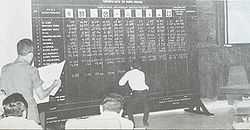Indonesian legislative election, 1971
 |
| This article is part of a series on the politics and government of Indonesia |
| Pancasila (national philosophy) |
| Constitution |
|
Executive
|
| Foreign relations |
|
Politics portal |
Indonesia's second legislative election, and the first under the New Order regime, was held on July 3, 1971. There were 10 participants; 9 political parties and the "functional group" Golkar.
Background

Following the Transition to the New Order from 1965–1967, the army-backed New Order regime announced that the Golkar organization would be its political vehicle. The regime stressed that Golkar (meaning "functional group") was not a political party. In order to give General Ali Murtopo time to turn Golkar into an organization fit to command a majority in the legislature, the general election originally planned for no later than July 5, 1968 was postponed to no later than July 5, 1971.[1]
After a time with no word from the government concerning the forthcoming election, on October 22, 1968, the Sinar Harapan daily reported a statement by President Suharto to the effect that the government had begun to take the necessary steps to organize the poll. A General Election Board was established in mid-1969 headed by Interior Minister Amirmachmud.[2] On September 23, 1970, the ballot paper numbers and electoral symbols for the 10 election participants were announced.[3]
Government manipulation

In order to weaken possible rivals to Golkar, the government manipulated the top two parties from the 1955 election, the Indonesian National Party and Parmusi (the successor to Masjumi following that party's banning in 1960) such that they lost credibility in the eyes of voters.[1] Given that the party that had come fourth, the Indonesian Communist Party, had been banned in the aftermath of the 30 September Movement coup attempt in 1965, that left only the Nahdatul Ulama as a major rival.[4]
Away from the political parties, civil servants were effectively obliged to vote Golkar and regional administrators were required to fulfill "quotas" of Golkar votes.[1]
The system of allocating seats was changed from that of the 1955 election to reduce the number of parties winning seats in the legislature. All seats were to be allocated in the regional electoral districts, rather than being divided up based on national results.[5]
Preparations
A total of 6,000 tons of paper, 6 ships, 45,000 motor vehicles and 793,036 ballot boxes (lockable to ensure secrecy of the ballot) were needed for the election.[6]
Results
| Parties | Votes | % | Seats |
|---|---|---|---|
| Golkar | 34,348,673 | 62.80 | 236 |
| Nahdatul Ulama (NU) | 10,213,650 | 18.67 | 58 |
| Indonesian National Party (Partai Nasional Indonesia) | 3,793,266 | 6.94 | 20 |
| Muslim Party of Indonesia (Partai Muslimin Indonesia) | 2,930,746 | 5.36 | 24 |
| Indonesian Islamic Union Party (PSII) (Partai Syarikat Islam Indonesia) | 1,308,237 | 2.39 | 10 |
| Indonesian Christian Party (Parkindo) (Partai Kristen Indonesia) | 733,359 | 1.34 | 7 |
| Catholic Party (Partai Katolik) | 603,740 | 1.10 | 3 |
| Islamic Educators Association (Perti) (Persatuan Tarbiah Islamiah) | 381,309 | 0.69 | 2 |
| League of Upholders of Indonesian Independence (IPKI) (Ikatan Pendukung Kemerdekaan Indonesia) | 388,403 | 0.62 | - |
| Murba Party (Partai Murba) (Murba means Musyawarah Rakyat Banyak) | 48,126 | 0.09 | - |
| Total counted | 54,699,509 | 100% | 360 |
References
Bibliography
- IKAPI (Indonesian Student Press Association) (1972) Pemilihan Umum 1971 (1971 General Election) LPKP, Jakarta
- KPU (General Elections Commission) (2000) Pemilu Indonesia dalam Angka dan Fakta: Tahun 1955-1999 (Indonesian Elections in Facts and Figures: 1955-1999, KPU Public Relations Bureau, Jakarta
- Liddle, R. William (1994) Pemilu-Pemilu Orde Baru (Elections of the New Order), LP3ES, Jakarta ISBN 979-8015-88-6
- Ricklefs, M.C. (1991). A history of modern Indonesia since c.1200. Stanford: Stanford University Press. ISBN 0-8047-4480-7
- Schwartz, Adam (1994) A Nation in Waiting: Indonesia in the 1990s, Allen & Unwin. ISBN 1-86373-635-2
- Sekretariat Negara Republik Indonesia (1975) 30 Tahun Indonesia Merdeka: Jilid 3 (1965-1973) (30 Years of Indonesian Independence: Volume 3 (1965-1973)
| ||||||||||